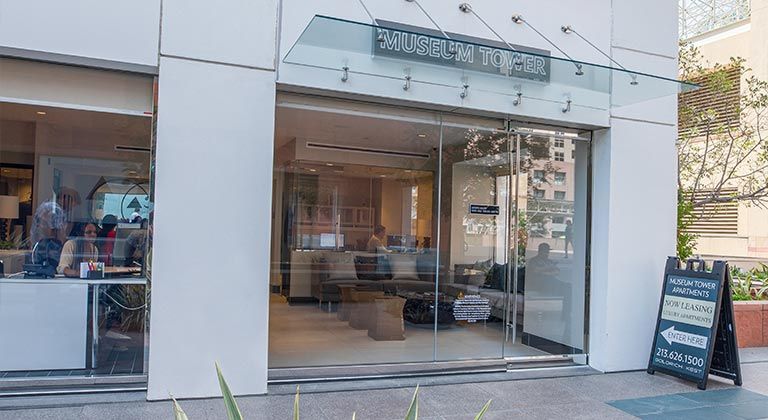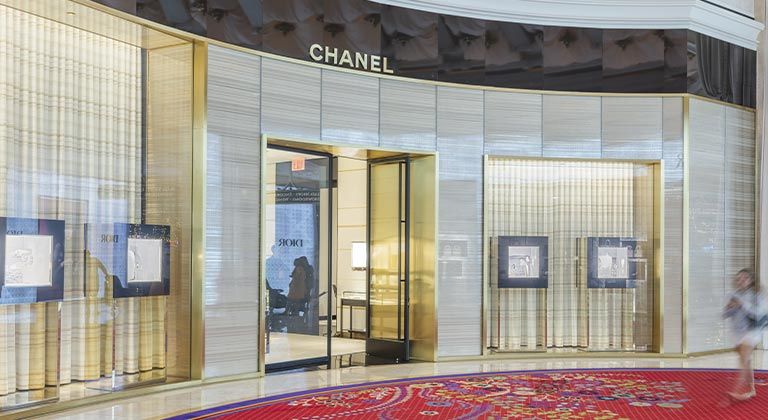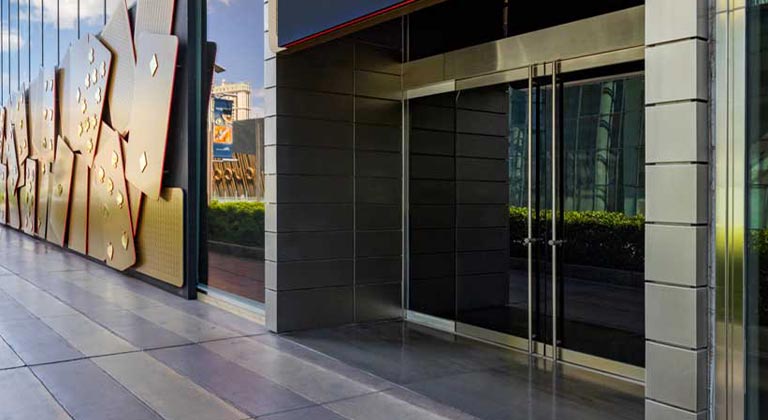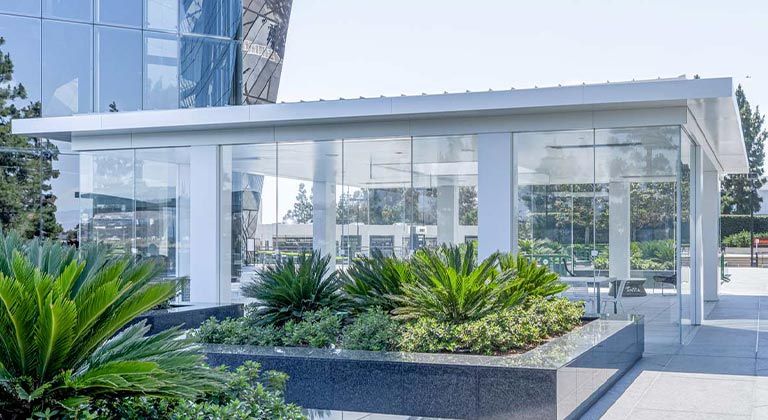
The use of acoustic laminated glass for front door and storefront is critical for designers and building owners seeking to manage noise levels in commercial buildings. This measure is a vital step towards sustaining office productivity, promoting comfort, and fostering a more tranquil atmosphere.
Definition of Acoustic Laminated Glass
Laminated glass is comprised of layers – two or more panes of glass with a clear (typically vinyl) interlayer holding them together. We can improve sound insulation in glass in diverse ways: increasing the thickness of the pane, using laminated glass on its own or within an insulating glass unit (“IGU”), in which the larger the air gap between the panes, the more effective the insulation.
The best soundproofing performance is obtained with the installation of acoustic laminated glass. Acoustic glass is made by laminating two pieces of glass together with a sound-blocking Polyvinyl butyral (PVB) inner membrane. This means that all acoustic glass is laminated, but not all laminated glass is acoustic, if the PVB interlayer is not part of its composition.
There are certain struggles that designers and architects often face when improving noise control and comfort in a commercial space. In this article, we will review challenges, benefits and best practices related to using acoustic laminated glass.
Challenges Encountered by Designers, Architects, and Contractors when Attempting to Improve Acoustics
One of the most significant hurdles architects and contractors must overcome when working on acoustics for a project is negotiating an accurate budget for that factor. Building acoustics are often placed low on the list of building performance priorities, as they compete with higher-level project goals that may be more expensive or deemed higher in importance.
The most economical method to install glass with the goal of soundproofing is to think about it from the point of design and make it part of the initial construction. A more costly way to address the issue would be to try to save budget on the initial build, only to discover later, once the building is complete, that outside noise is problematic enough to justify a renovation. Replacing existing glazing with sound insulating solutions later is always an option, but overall, the costs of glazing twice will always be greater than doing it just once and minimize any downtown and inconvenience caused by a remodel.
Challenges differ by project, but there are a few common challenges many commercial projects face, including:
- Audible or excessive noise coming in from outside the building
- Noise from nearby areas
- Lack of control over the sound within the internal space
Additional factors may need to be addressed according to the needs of each individual project. For instance, each space within a commercial building can require a different level of acoustic sound management. The requirements of a lobby may differ from the soundproofing needs of a conference room or medical examination room.
Different commercial buildings may require distinct levels of sound control depending on each building’s use. A library, an office space, meeting rooms within an office space, or a recording studio would have unique needs and require different acoustic treatments.
Either the combination of materials used in the exterior glazing of a project, or any one of them alone, can significantly enhance sound insulation and comfort. Factors such as window thickness, sealants, double-, or triple glazing, can each help to reduce outdoor sounds.
Benefits of Acoustic Laminated Front Door and Storefront Glass for Commercial Installations
When compared to using double-glazing, for example, the benefits of installing acoustic laminated front doors and storefront glass make it worthwhile. In addition to noise reduction and improved comfort, using acoustic laminated glass provides other considerable advantages.
Noise reduction and improved comfort
Acoustic laminated glass aims to minimize noise transmission. Its PVB layer reduces sound transmission by decreasing the energy of sound waves, leading to a notable reduction in noise.
It’s an excellent choice for commercial spaces located in busy urban areas, near high-traffic zones, or by airports or train routes. It can effectively block out external sounds, such as traffic, construction noise, or sirens, creating a quieter and more productive indoor environment.
Enhanced security and safety
Sometimes also referred to as “safety glass,” acoustic laminated glass has other benefits that make it widely popular, due to its composition that includes a PVB layer. In the event of breakage, it forms a spider web pattern from the point of impact, and the shards remain bonded to the interlayer, reducing the risk of injury. This reduces the chances of injury compared to a regular pane of glass, which breaks easily, and scatters sharp glass shards, causing dangerous conditions.
The inner layer of PVB also makes it more difficult to break, ensuring greater security than tempered or annealed glass would provide. Its greater strength can help to discourage or prevent break-ins.
Energy efficiency and eco-friendliness
The robust design of acoustic glass ensures that the temperature inside the room is maintained at an optimal level. This results in equipment operation inside the building more likely to be consistent, without fluctuations, thus increasing energy efficiency.
Similarly, single-pane glass does not provide energy efficiency or temperature control. Although the thickness between any panes of glass can vary, warmth and cold can transfer easily if using just a single pane.
Acoustic laminated glass is thick. It can provide additional protection from weather elements, such as high winds or extreme temperatures. When installed correctly, occupants can reduce their dependency on air conditioning and heaters, thus reducing their energy consumption.
Aesthetic appeal and customizability
Acoustic laminated glass comes in different thicknesses, sizes, and finishes, allowing for more design possibilities in commercial spaces. It can be customized to meet aesthetic needs and blend with the overall design.
To achieve desired acoustic performance levels, various interlayer materials and glass types can be utilized.
Additional benefits of acoustic laminated front door and storefront glass include:
-
- Enhanced privacy
- Improved productivity
- Protection from ultraviolet (UV) and infrared (IR) rays, while allowing just the light to pass through the windows.
These benefits are ideal for creating comfortable, functional, and aesthetically pleasing conditions for office buildings, hotels, hospitals, educational institutions, and other commercial settings.

Best Practices for Installing Acoustic Laminated Front Door and Storefront Glass
Here are a few best practices to consider for your project.
When choosing glass for soundproofing, thicker glass is generally more effective than thinner glass. Glass thicknesses of single layers of glass typically range from one-eighth of an inch to one inch.
An equally important factor to consider is the STC rating of your glass. Consider the decibel value (dB) levels and how much noise your application needs to withstand. For higher noise levels, laminated, or double-paned glass provides extra protection.
Consider how these types of laminated glass and their respective thicknesses correspond to STC ratings:
- ¼-inch glass yields an STC rating of about 31
- 3/8-inch glass yields an STC rating of about 34
- 3/8-inch of standard laminated yields an STC rating of about 36
- 1/2-inch of glass yields an STC rating of about 36
- 1/2-inch of standard laminated yields an STC rating of about 37
- 3/8 inch of acoustical laminated yields an STC rating of about 37-38
- 1/2-inch of acoustic laminated yields an STC rating of about 38-39
Regardless of the selected soundproofing materials chosen, in general, all glass and glazing solutions adhere to five principles for the best outcome. These are:
- Thickness: Using thicker glass makes it more difficult for noise to penetrate.
- Amount of separation: Based on the principle of separation, sound requires air to travel through. If fewer materials are present for the sound to move through, it will diminish more quickly.
- Absorption: The more effectively surface areas absorb sound, the more sound will be eliminated or weakened.
- Resonance dampening: Some materials can reduce sound levels.
- Conduction: As sound travels, its intensity decreases.
Other factors that contribute to the acoustic properties of a building’s window system include the framing system used along with the sealants.

Giroux Glass, Inc. Is Your Acoustic Laminated Front Door and Storefront Glass Expert
Acoustic laminated front door and storefront glass is a great option for the safety and security of your business, noise reduction and comfort, eco-friendliness, and energy efficiency while providing the ideal aesthetic appeal your business deserves.
For all matters related to the installation of acoustic laminated and other glazing systems, consult the experienced professionals at Giroux Glass, Inc. Giroux Glass is a reputable company that offers exceptional glass, glazing, and architectural metal services. Their skilled union glaziers deliver top-notch results, even on the most challenging engineering obstacles. They specialize in demanding projects for commercial and retail sectors.

